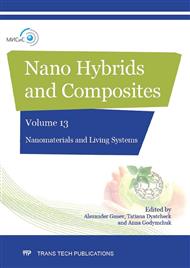[1]
X. Yang, H. Pan, P. Wang, F. Zhao, Particle-specific toxicity and bioavailability of cerium oxide (CeO2) nanoparticles to Arabidopsis thaliana, J. Hazard. Mater. (2016) In Press.
DOI: 10.1016/j.jhazmat.2016.03.054
Google Scholar
[2]
G. Vale, K. Mehennaoui, S. Cambier, G. Libralato, S. Jomini, R. F. Domingos, Manufactured nanoparticles in the aquatic environment-biochemicalresponses on freshwater organisms: A critical overview, Aquat. Toxicol. 170 (2016) 162-174.
DOI: 10.1016/j.aquatox.2015.11.019
Google Scholar
[3]
D. Lin, J. Ji, Z. Long, K. Yang, F. Wu, The influence of dissolved and surface-bound humic acid on the toxicity of TiO2 nanoparticles to Chlorella sp., Water. Res. 46 (2012) 4477-4487.
DOI: 10.1016/j.watres.2012.05.035
Google Scholar
[4]
C. Cerrillo, G. Barandika, A. Igartua, O. Areitioaurtena, G. Mendoza, Towards the standardization of nanoecotoxicity testing: Natural organic matter camouflages, the adverse effects of TiO2 and CeO2 nanoparticles on green microalgae, Sci. Total. Env. 543 (2016).
DOI: 10.1016/j.scitotenv.2015.10.137
Google Scholar
[5]
S. Pakrashi, S. Dalai, N. Chandrasekaran, A. Mukherjee, Trophic transfer potential of aluminium oxide nanoparticles using representative primary producer (Chlorella ellipsoides) and a primary consumer (Ceriodaphnia dubia), Aquat. Toxicol. 152 (2014).
DOI: 10.1016/j.aquatox.2014.03.024
Google Scholar
[6]
Yu.N. Morgalev, T.G. Morgaleva, Yu.S. Grigoriev. Method of determining the toxicity index nanopowders products from nanomaterials, nano-coatings, waste and sewage sludge containing nanoparticles to modify the optical density of the test culture algae Chlorella (Chlorella vulgaris Beijer), FR. 1. 39. 2010. 09103.
Google Scholar
[7]
A.A. Shlyk, Determination of Chlorophylls and Carotenoids in Extracts of Green Leaves, Moscow, Nauka, (1971).
Google Scholar
[8]
A.M. Gorky, Plant and Stress: Course of Lectures, Ekaterinburg, Ural State University, (2012).
Google Scholar
[9]
N.D. Smashevsky, Practical Work on Plant Physiology, Astrakhan, Astrakhan State University, (2011).
Google Scholar
[10]
N.D. Smashevsky, Photosynthesis and Ecology, Astrakhan, Astrakhan State University, (2012).
Google Scholar
[11]
S. Yu. Morgalev, T.G. Morgaleva, Y.N. Morgalev, I.A. Gosteva, Stability of Disperse Systems during Bioassay of Nanoecotoxicity with use of Aquatic Organisms, Adv. Mater. Res. 1085 (2015) 424–429.
DOI: 10.4028/www.scientific.net/amr.1085.424
Google Scholar
[12]
B. Zheng, T. Kong, X. Jing, T. Odoom-Wubah, X. Li, D. Sun, F. Lu, Y. Zheng, J. Huang, Q. Li, Plant-mediated synthesis of platinum nanoparticles and its bioreductive mechanism, J. Colloid Interf. Sci. 396 (2013) 138-145.
DOI: 10.1016/j.jcis.2013.01.021
Google Scholar
[13]
A. Zieli´nska-Jurek, Z. Wei, I. Wysocka, P. Szweda, E. Kowalska, The effect of nanoparticles size on photocatalytic and antimicrobial properties of Ag-Pt/TiO2 photocatalysts, Appl. Surf. Sci. 353 (2015) 317-325.
DOI: 10.1016/j.apsusc.2015.06.065
Google Scholar
[14]
D. Yuan, X-q. Shan, Q. Huai, B. Wen, X. Zhu, Uptake and distribution of rare earth elements in rice seeds cultured in fertilizer solution of rare earth elements, Chemosphere. 43 (2001) 327–337.
DOI: 10.1016/s0045-6535(00)00142-9
Google Scholar
[15]
L. Wang, J. Li, Q. Zhou, G. Yang, X.L. Ding, X. Li, C.X. Cai, Z. Zhang, H.Y. Wei, T.H. Lu, X.W. Deng, X.H. Huang, Rare earth elements activate endocytosis in plantcells, P. Natl. Acad. Sci. USA. 111(35) (2014) 12936-12941.
DOI: 10.1073/pnas.1413376111
Google Scholar
[16]
Q. Wang, X. Ma, W. Zhang, H. Pei, Y. Chen, The impact of cerium oxide nanoparticles on tomato (Solanum lycopersicum L. ) and its implications forfood safety, Metallomics. 4(10) (2012) 1105-1112.
DOI: 10.1039/c2mt20149f
Google Scholar
[17]
D. Minetto, A. Volpi Ghirardini, G. Libralato, Saltwater ecotoxicology of Ag, Au, CuO, TiO2, ZnO and C60 engineered nanoparticles: An overview, Environ. Int. 92–93 (2016) 189-201.
DOI: 10.1016/j.envint.2016.03.041
Google Scholar
[18]
G. Mustafa, S. Komatsu, Toxicity of heavy metals and metal-containing nanoparticles on plants, Biochim. Biophys. Acta. (2016) In Press.
Google Scholar
[19]
T.Y. Suman, S.R. Radhika Rajasree, R. Kirubagaran, Evaluation of zinc oxide nanoparticles toxicity on marine algae Chlorella vulgaris through flow cytometric, cytotoxicity and oxidative stress analysis, Ecotox. Env. Safety. 113 (2015) 23-30.
DOI: 10.1016/j.ecoenv.2014.11.015
Google Scholar
[20]
B. Hafeez, Y.M. Khanif, M. Saleem, Role of Zinc in Plant Nutrition- A Review, Am. J. Exp. Agr. 3(2) (2013) 374-391.
Google Scholar
[21]
S. Dinesh Kumar, P. Santhanam, S. Ananth, A. Shenbaga Devi, R. Nandakumar, B. Balaji Prasath, S. Jeyanthi, T. Jayalakshmi, P. Ananthi, Effect of different dosages of zinc on the growth and biomass in five marine microalga, Int. J. Fish. Aquacult. 6(1) (2014).
DOI: 10.1007/978-3-642-38200-0_8
Google Scholar
[22]
N. Gong, K. Shao, W. Feng, Z. Lin, C. Liang, Y. Sun, Biotoxicity of nickel oxide nanoparticles and bio-remediation by microalgae Chlorella vulgaris, Chemosphere. 83 (2011) 510-516.
DOI: 10.1016/j.chemosphere.2010.12.059
Google Scholar
[23]
I. Domonkos, M. Kis, Z. Gombos, Versatile roles of lipids and carotenoids in membranes, Acta Biol. Szeged. 59 (2015) 83-104.
Google Scholar
[24]
R.J. Cogdell, Carotenoids in photosynthesis, Pure. Appl. Chem. 57(5) (1985) 723-728.
Google Scholar


